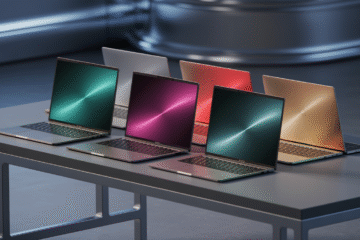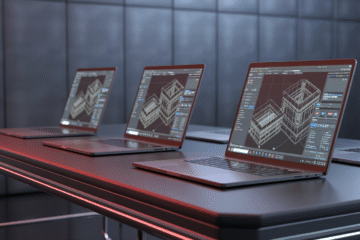Top 7 Best RTX Gaming Laptops (2025)
Gaming laptops in 2025 aren’t just desk replacements; they’re portable performance rigs with desktop-class silicon, DLSS 3 frame generation, AI upscalers, advanced cooling, and fast Mini-LED/OLED displays. If you want buttery-smooth 1440p/4K gameplay, creator-grade encodes, or esports-level frame rates, an NVIDIA GeForce RTX laptop is the most versatile way to do it on the go. This guide explains what actually matters (beyond marketing wattage), then ranks the Top 7 Best RTX gaming laptops from 7 to 1 based on performance per watt, thermals, display quality, upgradability, acoustics, and value.
What Really Matters for an RTX Gaming Laptop
GPU Power Budget (TGP) and Cooling
Two laptops with the “same” RTX chip can perform very differently. Look for:
-
TGP (Total Graphics Power): Higher TGP models sustain higher clocks.
-
Cooling design: Vapor chambers, dual fans, and big heatpipe arrays keep noise and temps sane during long sessions.
-
Advanced modes: Manufacturer performance profiles (Turbo/Overboost/AI modes) often unlock the laptop’s full TGP when plugged in.
CPU Throughput
High-refresh 1080p/1440p gaming and simulation/strategy titles can be CPU-limited. Recent Intel Core Ultra HX chips or AMD Ryzen HX parts with plenty of P-cores/threads help keep 200+ fps headroom in esports.
Display Matters More Than You Think
-
Resolution & Refresh: 16:10 QHD+ (2560×1600) at 240–320 Hz is a sweet spot for clarity and speed.
-
Panel tech: Mini-LED and OLED elevate contrast and HDR; fast IPS panels are excellent all-rounders.
-
G-SYNC/FreeSync + Advanced Optimus/MUX: Tear-free frames and the ability to bypass iGPU when you want raw dGPU performance.
Memory, Storage & Upgrades
-
RAM: 16GB is entry; 32GB is ideal for modern games + creator apps + background tasks.
-
Storage: 1TB NVMe minimum; PCIe 4.0/5.0 SSDs cut load times. Two slots mean painless expansion.
I/O, Battery & Build
-
I/O: USB-C (100W+ PD), Thunderbolt/USB4 (on Intel), 2.5GbE or better for LAN, HDMI 2.1/DP 1.4 for external 4K/120 monitors.
-
Battery: Don’t expect miracles under full load, but 90–99Wh cells plus hybrid modes help for travel.
-
Chassis: Rigid lids/hinges and a good keyboard feel matter for long sessions and commute durability.
7: Alienware 18 Area Gaming Laptop – Max-Screen Spectacle for Couch Commanders
Why It’s on the List
Alienware 18 Area Gaming Laptop is a big, bold statement piece: massive display real estate, premium build, and the brand’s signature sci-fi design. If you want a portable desktop experience, emphasis on desktop, the 18-inch canvas is a joy for cinematic single-player, racing sims, and multitasking streams.
Performance & Thermals
Alienware’s robust cooling (vapor chamber + high-airflow fans on many configs) and generous power budgets let RTX GPUs stretch their legs. Expect excellent sustained fps in 1440p/4K with DLSS 3, though acoustics under Turbo get assertive as expected for the size.
Display & Controls
Large high-refresh QHD+ or 4K panels with G-SYNC options make games feel fluid and detailed. The keyboard leans toward full-size comfort; per-key lighting looks the part.
Who It’s For
Gamers who want the biggest screen and a premium look/feel, and who don’t care about a few extra pounds in the bag.
Considerations: Heavier and pricier than midrange 16-inch rigs; battery life is travel-only. Portability takes a back seat to spectacle.
6: Acer Predator Helios Neo 14 Gaming Laptop – Compact Predator With Real Bite
Why It’s on the List
The Acer Predator Helios Neo 14 Gaming Laptop squeezes serious RTX horsepower into a compact chassis that’s easier to travel with than 16–18″ behemoths. It’s the “go-anywhere, game-anywhere” option without giving up modern features.
Performance & Thermals
For its size, the Helios Neo 14 offers impressive TGP and tuned Predator profiles. With Advanced Optimus (on many SKUs), you can run the panel straight off the dGPU for max fps or switch to hybrid mode to save power.
Display & Controls
A quick QHD-class panel at high refresh is common in this line, with solid color for creators. The keyboard is crisp, the trackpad accurate, and the chassis feels sturdier than typical ultralight gamers.
Who It’s For
Students, commuters, and LAN-party regulars who want high refresh QHD in a 14″ footprint.
Considerations: Smaller chassis = more audible fans at full tilt; sustained top-end performance trails larger vapor-chamber rigs simply due to physics.
5: ASUS ROG Strix G18 Gaming Laptop – Big Frames, Big Screen, Big Value
Why It’s on the List
The ASUS ROG Strix G18 Gaming Laptop brings 18-inch immersion at aggressive pricing relative to halo 18-inch flagships. If you want an expansive panel and serious RTX throughput without the flagship premium, this is a sweet spot.
Performance & Thermals
ASUS’s Strix cooling (often multi-heatpipe + liquid metal on CPU in many configs) helps sustain higher GPU clocks during long raids or open-world sessions. Expect excellent 1440p performance with room for high/ultra settings.
Display & Controls
High-refresh QHD+ with 16:10 is common; colors are strong for content creation. The keyboard is gamer-tuned with deep travel and per-zone RGB, and the chassis has ROG flair without being over the top.
Who It’s For
Gamers who want 18-inch immersion and RTX muscle at a palatable price, plus streamers who benefit from the larger UI space.
Considerations: Size and weight are still significant; the battery is fine for browsing but not for sessions.
4: GIGABYTE AORUS Master 16 Gaming Laptop – Creator-Caliber Colors Meet RTX Muscle
Why It’s on the List
The GIGABYTE AORUS Master 16 Gaming Laptop leans into color-accurate displays and refined cooling, making it ideal for gamers who also edit, grade, or 3D render. AORUS often validates panels for wider gamuts and better factory calibration.
Performance & Thermals
AORUS thermal solutions keep clocks high without screaming fans in “balanced” profiles, and you can unleash full performance when plugged in. RTX with DLSS 3 and Frame Gen delivers QHD+ high-refresh bliss in modern titles.
Display & Controls
Expect vibrant QHD+ 16:10 at high refresh with excellent uniformity. The keyboard is comfortable for long use, and the build quality is solid, leaning “pro” more than “flashy.”
Who It’s For
Hybrid gamer-creators who care about accurate color in DaVinci/Adobe but still want top-tier fps after hours.
Considerations: Pricing can creep up with premium displays/SSDs; RAM/SSD upgradability is a plus spec, it’s smart from the start.
3: ASUS ROG Strix G16 Gaming Laptop – The 16-Inch Sweet Spot
Why It’s on the List
The ASUS ROG Strix G16 Gaming Laptop nails the balance of size, thermals, price, and performance. The 16-inch 16:10 format is the modern sweet spot for QHD+ high-refresh gaming that still fits most backpacks.
Performance & Thermals
Strong TGP allocations and competent cooling let high-end RTX SKUs run hard. You’ll see triple-digit fps at QHD+ in most shooters with DLSS 3, and quiet-ish fans if you dial profiles thoughtfully.
Display & Controls
ASUS continues to deliver excellent gamer panels (QHD+ 240 300 Hz options) with good color. The keyboard is responsive with robust arrow keys; the trackpad is large and smooth.
Who It’s For
Players who want flagship-adjacent performance in a more practical size, esports, AAA, and creative work in one machine.
Considerations: Not as flashy as SCAR or TITAN; if you want the absolute bleeding edge of CPU/GPU bins and overbuilt cooling, keep reading.
2: ASUS ROG Strix SCAR 18 Gaming Laptop – Overbuilt for Victory Laps
Why It’s on the List
The ASUS ROG Strix SCAR 18 Gaming Laptop is ROG’s “turn it to 11” ethos: top-bin chips, huge cooling, and aggressive power envelopes. If you want the highest sustained fps this side of a portable desktop and a panel to match, the SCAR 18 is the weapon.
Performance & Thermals
A colossal vapor-chamber design, high TGP RTX options, and tuned fans deliver desktop-rivaling frames over long sessions. With DLSS 3 FG, you can run ultra settings at QHD+ and even flirt with 4K external displays.
Display & Controls
Expect elite QHD+/4K panels with high refresh and wide gamut. The keyboard has fast response and confident travel; RGB is plentiful; the chassis gets the full ROG treatment.
Who It’s For
Competitive gamers and power users who want top percentile performance and don’t mind a larger footprint.
Considerations: Size, weight, and price are all up there. The battery is for travel between outlets, not gaming.
1: MSI Titan 18 HX AI Gaming Laptop – The Portable Flagship
Why It’s on the List
The MSI Titan 18 HX AI Gaming Laptop is the “no-compromise” champion: max-bin HX CPUs, ultra-high TGP RTX GPUs, overbuilt (and beautiful) cooling, plus premium panels. It’s as close to a desktop as a laptop gets, and still close to fit a backpack.
Performance & Thermals
This is where you chase records: desktop-class boost behavior, sustained clocks, and thermal capacity that keeps the RTX pumping frames for hours into a raid. AI-assisted profiles and fine control utilities let you tailor acoustics vs performance. Pair with a 4K/120 external, and it still flexes.
Display & Controls
Top-end QHD+/4K fast panels with HDR capacity, brutal clarity, and deep contrast. The mechanical-feel keyboard on many TITANs is a joy; the trackpad area and palm rests are generous.
Who It’s For
Gamers and creators who want the absolute best laptop gaming experience, 4K/high refresh ambitions, uncompromised settings, and pro-grade creation on the same machine.
Considerations: Price and mass are hefty. If you want “every slider to the right,” it’s worth it. If you’re cost-sensitive, the G16/G18 tier often hits 90% of the experience for less.
Performance Tiers & Use-Case Guide
Esports & High-Refresh 1440p
-
Best Picks: ASUS ROG Strix G16, AORUS Master 16
-
Why: High-refresh QHD+ panels, strong TGP, practical size for events.
AAA at Ultra + DLSS 3
-
Best Picks: Strix G18, Strix SCAR 18, Alienware 18 Area
-
Why: Big cooling, high TGP, and huge displays for cinematic experiences.
4K External + Creation Work
-
Best Picks: MSI Titan 18 HX AI, AORUS Master 16
-
Why: Top-bin RTX for 4K/120 ambitions; creator-grade panels and I/O.
Travel-Friendly Power
-
Best Pick: Acer Predator Helios Neo 14
-
Why: QHD at real frame rates in a 14″ chassis; Advanced Optimus keeps it flexible.
Buying Tips That Save Headaches
1) Pick the Right Panel First
You stare at it for years. QHD+ 240–320 Hz is a brilliant balance. Mini-LED/OLED adds contrast and HDR po, worth it if you also watch films or grade footage.
2) Prioritize TGP and Cooling Over “Model Name”
A slightly lower-tier GPU with higher TGP and better cooling often beats a higher “tier” starved for power.
3) Get 32GB RAM If You Stream/Create
Games + Chrome + OBS + Discord + plugins can swallow 16GB quickly. Many rigs let you upgrade later, check SODIMM access.
4) Two NVMe Slots Are Gold
Keep OS on drive 1, games/scratch on drive 2. PCIe 4.0/5.0 SSDs deliver instant map loads and fast project scrubs.
5) Demand a MUX/Advanced Optimus
Being able to run your internal panel straight from the dGPU means higher fps and lower latency when you want it.
6) Undervolt/Profiles = Free Wins
Vendor utilities (and BIOS options on enthusiast models) let you dial noise down and thermals up intelligently without sacrificing fps.
Frequently Asked Questions
Q: Are 18-inch laptops overkill?
If you rarely move the machine and love immersion, 18″ is amazing. For campus or frequent travel, the 16″ balances space and portability better.
Q: QHD+ 240 Hz vs 4K 120 Hz?
QHD+ 240 Hz is perfect for shooters and competitive play. 4K 120 is gorgeous for single-player and creator workflows, but needs top-tier RTX to drive.
Q: How important is DLSS 3 Frame Generation?
Very—especially at QHD/4K. FG + DLSS Quality yields huge fps boosts with minimal visual compromise in supported titles.
Q: What about battery life?
Gaming = plugged in. On the road, expect hours of browsing/video, not gameplay. Advanced Optimus helps when you’re off charger.
Final Verdict
-
Best Overall & Uncompromised: MSI Titan 18 HX AI Gaming Laptop crown-jewel performance, display, and cooling.
-
Runner-Up Flagship: ASUS ROG Strix SCAR 18 Gaming Laptop top-bin parts and overbuilt thermals for sustained wins.
-
Best 16-inch Balance: ASUS ROG Strix G16 Gaming Laptop, superb QHD+ high-refresh gaming in a practical chassis.
-
Creator-Friendly Pick: GIGABYTE AORUS Master 16 Gaming Laptop color-credible panel + RTX muscle.
-
Best Value Big Screen: ASUS ROG Strix G18 Gaming Laptop, huge canvas, huge frames, saner price.
-
Best Compact Power: Acer Predator Helios Neo 14 Gaming Laptop, travel-friendly QHD performance.
-
Best Style-Forward 18″: Alienware 18 Area Gaming Laptop, premium build and cinematic feel for big-screen fans.
Whichever rig you choose, prioritize QHD+ high-refresh panels, MUX/Advanced Optimus, high TGP, 32GB RAM, and dual NVMe slots. Those choices shape every match, every render, and every late-night raid—long after the unboxing glow fades. Game on.



0 Comments